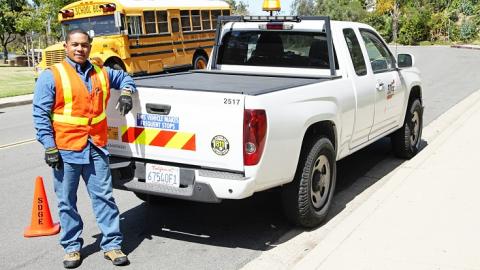After 15 years on the job as an SDG&E Gas Patroller, Jon Brown knows the streets of San Diego pretty well. Not only is he familiar with his routes, he’s also grown used to the funny looks he often receives while making his rounds through neighborhoods.
“When customers see us out here in the community, they wonder why we’re here with these strange looking devices they’ve never seen before,” said Brown. “It’s nice to be able to assure residents that we are out here every day for their safety.”
Natural gas safety’s A-team
Brown is part of a team of natural gas patrollers who conduct leak and corrosion surveys each day to ensure the natural gas system is operating safely and reliably. Patrollers use extremely sensitive handheld and vehicle-mounted devices called optical methane detectors to detect even the smallest amounts of natural gas using infrared laser technology.
If Brown or one of his colleagues discovers a potential leak, the situation is evaluated more closely and a plan is put into place to repair the leak, if one is present. With nearly 15,000 miles of natural gas pipelines in San Diego and hundreds of thousands of local homes and businesses relying on natural gas every day, it’s critical to keep the system running safely and reliably.
“Natural gas is important to our customers whether they are cooking, heating their home or swimming in their pools,” said Brown. “We want to make sure gas is available to them when they need it—but most importantly, we want to make sure it’s safe.”
One of the most common causes of pipeline leaks is from damage caused by third-party contractors or residents who don’t contact 811 to have underground gas lines marked before they dig. If you or your contractor is digging to plant a tree or start a landscape renovation, be sure to contact 811 or DigAlert at least two days before you start your project to make sure you’re aware of any utility lines below, including natural gas lines.
Follow your nose
While state-of-the-art technology and training are essential for detecting leaks, gas patrollers also rely on a more “old fashioned” tool you’re likely more familiar with: their noses. Just as equipment undergoes testing, so do some of our employees’ noses. Gas patrollers are routinely tested on how quickly and accurately they can smell natural gas, ensuring these select employees are ready to act if they catch a whiff of gas while in the field.
And, while some days may more tiring than others—depending on how many miles they walk—for gas patrollers like Jon Brown, each day brings job satisfaction.
“I know at the end of the day, I did my part ensuring that our customers are safe,” Brown noted. “It’s important San Diegans know the natural gas they rely on in their daily lives will be there when they need it.”


